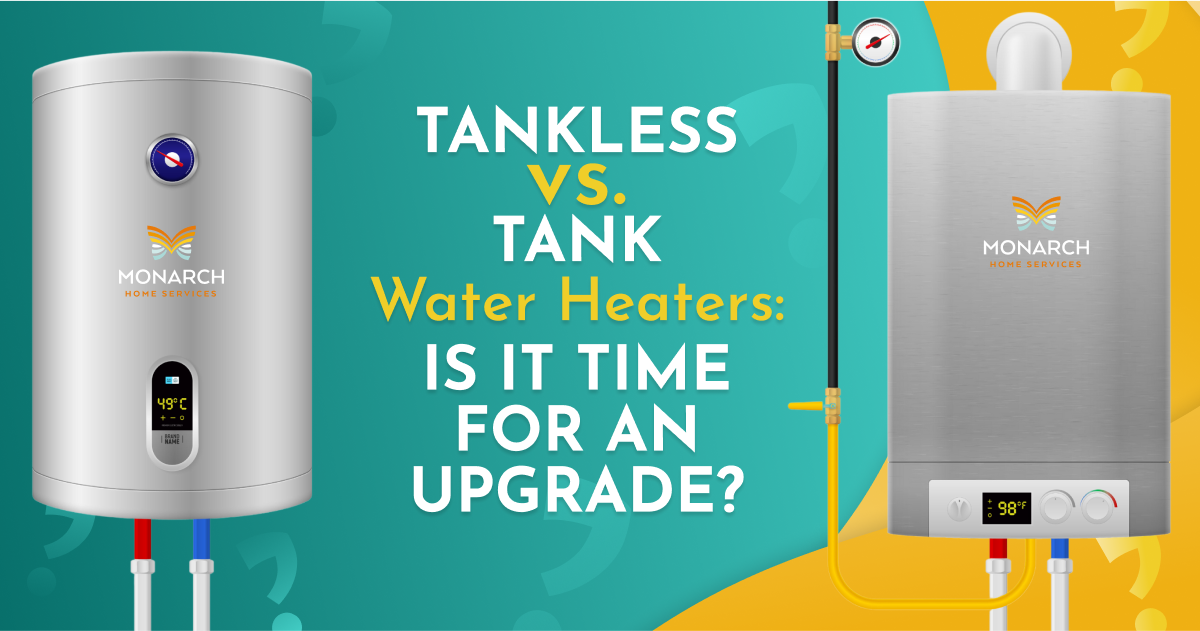You may compare tankless vs. tank water heaters if your old unit is becoming less reliable. In this case, an upgrade may be in order. Homeowners in the San Joaquin Valley turn to Monarch Home Services for water heater replacement and other services. As technology has progressed, so have our options. If you’re unsure which to choose, we’ll compare their differences to make your decision easier.
Should I Go Tankless?
Conventional water heaters are bulky and store heated water in a tank. However, technological advancements avoid this. Tankless water heaters heat water on demand as the incoming supply passes through the heat exchanger. They’re smaller and more efficient and can benefit you in other ways.
We’ll explore the different attributes of both to help you determine if it’s time for an upgrade:
Purchase/Installation Costs
The difference in initial costs is immediately noticeable when you compare tankless water heaters vs. tank models. Tank-based units are less costly. You can also save if the new unit is compatible with your existing hookup. For a plumber, installing a new tank water heater of the same capacity is a basic job.
The upfront cost of tankless water heater installation is higher. This goes for gas- and electric-powered models. A gas tankless water heater may require upgrades to your gas supply line and venting system. Meanwhile, installing an electric unit may require upgrading your home’s main electrical panel. To accommodate its power draw, you may need 200 amps or more of electrical service.
With those factors considered, you can plan and budget for a water heater upgrade that yields long-term savings. We’ll now compare tankless vs. tank water heaters further to help determine if an upgrade is worth it.
Function and Performance
In a tank model, hot water flows from the top of the tank when you open the hot water tap. Cold water refills at the bottom and is heated. Therefore, hot water is always available. Water is also stored until use and kept warm, so the unit consumes energy whether it’s in use or not.
However, on-demand water heaters don’t use a tank. Water is heated as it passes through the unit. As it does, a heat exchanger quickly increases its temperature, eliminating standby energy losses. The unit switches on and off as needed and delivers hot water within seconds.
Size
Size is another consideration. A standard tank is about 5 feet tall or more and about 2 feet wide, so space constraints can be an issue, especially when replacing the unit with another tank water heater of the same capacity (federal regulations now require more insulation so that new units may take up more space).
While tankless water heaters vary in size, they average roughly 2 feet tall and just over a foot wide. That’s small enough to mount on a wall in a closet.
Energy Efficiency
Traditional water heaters consume a lot of energy. They can strain your household budget, especially with the rising electricity and fuel costs. According to Energy.gov, a home that uses 41 gallons of water or less a day can improve efficiency by up to 34% with a demand water heater. Larger households that use up to 86 gallons per day can improve efficiency by up to 14%.
The higher purchase price of a tankless water heater can be offset by:
- Long-term energy savings
- Lower operating costs
- Longer equipment lifespan
Nonetheless, gas-fired tankless systems with a pilot light can waste energy. A burning pilot light can help increase the unit’s flow rate. But a standing pilot light isn’t the only option. Models with an intermittent ignition device can save energy.
Life Expectancy
Storage tank water heaters usually last from 10 to 15 years. However, tankless models can last over 20 years. Aside from fewer parts and reduced wear (since the unit only runs intermittently), tankless water heaters have easily replaceable parts. If you’re looking for a system with years of trouble-free performance, consider an on-demand water heater.
Capacity
Capacity is a major consideration when choosing any type of water heater. Generally, the capacity of a storage tank water heater is 30 to 60 gallons; 50 gallons is the most common size.
Tankless water heaters generally have a flow rate of 2 to 5 gallons per minute. The capacity you choose depends on the hot water needs of your household. Running multiple fixtures or water-using appliances can overwhelm the unit; choose carefully so you don’t run out of hot water. So long as you have a large enough water heater, this won’t happen.
To overcome any hot water supply issues, you can:
- Avoid running the shower and dishwasher simultaneously.
- Install two or more tankless water heaters for your home.
- Use separate tankless units for specific appliances.
- Install a demand water heater for a remote bathroom, hot tub, etc.
When Should I Replace My Water Heater?
If your water heater is 12 years old, meets your hot water needs, and doesn’t need costly repairs, don’t replace it yet. However, consider an upgrade if the unit leaks operates erratically, or is increasing your energy expenses. Loud noise and diminished water quality are also signs it’s time for a replacement. Choosing between a tankless vs. a tank water heater can cut energy costs and improve your well-being and the value of your home.
Monarch Home Services Installs Tankless Water Heaters
Our team is trained to install and service tankless water heaters in Bakersfield, Fresno, Visalia, and surrounding areas. A tankless system can conserve energy, reduce operating costs, and save space, not to mention provide unlimited hot water. If you’re considering an upgrade, let us compare tankless water heaters vs. tank options to help you make an informed decision. To schedule a free estimate, call (661) 452-8707 today.


